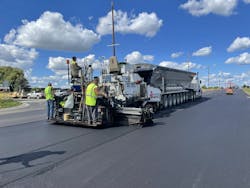By Chuck Mills and Brett Stanton, Contributing Authors
The Michigan Department of Transportation (MDOT) has been using a Life Cycle Cost Analysis (LCCA) method for pavement selection since 1985.
For any state-funded project with an estimated pavement cost exceeding $1.5 million, the analysis must include those costs associated with initial construction, future maintenance, user delay (for initial construction and future maintenance activities), and remaining life value.
MDOT uses these inputs to calculate the Equivalent Uniform Annual Cost (EUAC) and determine the most cost-effective pavement type.
Under this type of pavement selection process, low initial construction cost, quick construction, and minimal maintenance costs over the service life of the pavement contribute to the best return on investment. The industry must innovate and continuously improve its process and performance to remain competitive.
Asphalt pavements have remained competitive here thanks to MDOT’s continued partnership with the asphalt industry. From information sharing to specification reviews, the partners have worked together to increase performance of asphalt mixtures in Michigan.
Changes have been made in mixture specifications to improve durability. In fine-graded mixtures, the use of coarse-graded superpave mixtures was eliminated for top and leveling courses by changing the gradation requirements to remain above the maximum density line. The result: more asphalt cement in the mixture and less segregation while paving.
To further increase asphalt content in the mixtures, air voids were regressed only using asphalt cement. This means mixtures are still designed at 4% air, and then the appropriate amount of asphalt cement is added to achieve the target voids.
In 2012, the air void target was reduced from 4% to 3.5%. In 2015, it dropped to 3%. This overall regression has increased asphalt contents 0.4%.
How the asphalt cement is selected has also changed for high Recycled Asphalt Pavement (RAP) mixtures (18% to 27% RAP binder by weight of total binder).
The cold temperature properties of the binder have been lowered with the contractor option to lower the high temperature. Thus, “softer” binders are used.
The goal is to improve durability by providing protection against low temperature cracking in the asphalt mixture. The lower temperature of the performance grade for the Capital Preventive Maintenance Program was reduced, and the result was a softer design grade of asphalt cement.
For several projects, -28 was used instead of -22. The goal is to improve the resistance to cracking.
MDOT’s mix design practice was revised by eliminating back calculating air voids from Nmax to Ndesign. Mixtures are now compacted to Ndesign to determine the actual air void level. This increased asphalt content by about 0.1%.
The specification limits for the pay factors and quality assurance/quality control (QA/QC) limits have been changed based on data from projects.
MDOT uses Asphalt Cement Content (AC), Air Voids (AV), Voids in the Mineral Aggregate (VMA) and in-place density (via cores) as pay factors.
The pay is calculated using Percent Within Limit (PWL), a statistical method that requires consistency and being within the spec limits. This type of acceptance promotes a uniform, long-lasting pavement.
Since the implementation of PWL for payment, the spec limits are reviewed every five or six years. The goal of these reviews is to increase the quality of the HMA while specifying requirements that can still be achieved by the contractor.
The latest update increased the upper limit for asphalt cement content to avoid penalizing HMA that was above the upper spec limit for asphalt cement but still in spec for the other three pay factors.
The use of Stone Matrix Asphalt (SMA) also has been encouraged for use on freeways and limited access roads with heavy truck traffic. The spec limits for SMA were changed from VMA and AC to volume of effective binder, and the spec limits for air voids were changed.
This reduced testing variability that MDOT and the Asphalt Pavement Association of Michigan (APAM) saw in testing for pay. The goal of these changes was to encourage contractors to add asphalt cement to the mix and fairly pay the contractor for quality mixtures.
There also were changes made to the construction specifications and test methods to improve pavement performance.
In 2009, informational cores were taken, and a longitudinal joint density pilot spec was developed and used in 2011 on a few projects. The next year, all projects had the longitudinal joint density specification.
A core is taken for every 2,000-foot section, centered over the joint. The contractor can earn an incentive of up to $1.00 per linear foot of longitudinal joint.
For low density, there is a negative pay adjustment and any cores below a certain threshold can result in the contractor having to remove and repave the entire lane width. Since implementation of the longitudinal joint density specification, a 3% increase (89.8 to 92.8) in joint density has occurred since its inception.
“We think these changes made in partnership with APAM to the specs and construction practic-es will improve the quality of our HMA pavements,” said Nathan Maack, MDOT HMA Opera-tions Engineer.
Back-calculated asphalt content was eliminated for determining specification compliance. Contractors are given the choice of determining the asphalt cement content using the ignition oven or extraction. This allows the contractor to utilize more sound data to make necessary adjustments.
The allowable fines to effective asphalt cement ratio were reduced from 1.4 to 1.2. QA/QC monitoring was implemented and shutdown criteria. The goal is to prevent mixes from being brittle and crack susceptible.
The Hot Mix Asphalt (HMA) laboratory quality systems program was implemented, as well. All testing labs must meet program requirements including passing the annual HMA Round Robin Testing Program.
Additionally, a certification program, administered by Ferris State University and complies with the requirements of the Federal Highway Administration final rule 23CFR Part 637, ensures all (QA/QC) technicians must complete a standardized training course prior to testing asphalt mixtures.
This has improved the accuracy and consistency of both (QA/QC) testing and has significantly reduced the number of dispute resolution requests. Accurate and comparable test results are critical for determining specification compliance.
Results
All quality improvements made positively impact the performance of the asphalt pavements in the state. An increase in performance is visible when you drive the roads and also in MDOT’s pavement management data.
Since 2012, the service life of asphalt pavements has increased from 33 to 37 years for HMA reconstruction and from 26 to 32 years for HMA overlay over rubblized concrete pavements.
The improvements that have been made to asphalt pavements are directly responsible for the improved performance that MDOT has witnessed in its pavement performance curves.
There has been an increase in the number of HMA reconstruction projects over the last five years.
With such a dramatic increase in estimated service life, HMA overlay over rubblized could provide MDOT with an economical and environmentally friendly option for rehabilitation when reconstruction is not feasible.
The many quality improvements made to asphalt mixtures over the years have had dramatic impact on the pavement selection results.
Increasing the service life of asphalt pavements improves the life cycle cost by lowering the EUAC factor. The continuous improvement has positioned asphalt pavements to be the pavement type of choice in Michigan. Substantial increases of service life have a dramatic impact on the outcome of the LCCA process, couple that with a remaining service life credit and the EUAC factor for asphalt pavements is reduced even more.
MDOT’s use of LCCA to determine pavement type selection ensures that they are maximizing the return on investment of the taxpayer’s dollars. Quality improvements made by the partnership between the Department and the asphalt industry guarantees that Michigan enjoys the smoothest, quietest, and lowest life cycle cost pavement that money can buy. RB
Charles Mills, P.E., is director of engineering at the Asphalt Pavement Association of Michigan. Brett Stanton is the executive director at the Asphalt Pavement Association of Michigan.



